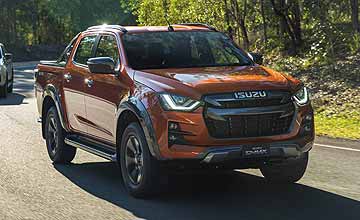
Overview
Since launching in Australia in 2008 with its Holden Colorado-based D-Max pick-up, Isuzu Ute Australia (IUA) has struck a chord with local buyers who want a reliable, no-nonsense ute that can keep up with the best the segment has to offer.
The second-generation version continued the rugged and reliable theme, with the brand achieving double-digit sales growth for every one of its first 10 years on sale.
With the arrival of a new decade comes the all-new, third-generation version, which the brand says has resulted in vast improvements to safety and refinement.
So how does the new-generation D-Max stack up against the competition.
First drive impressions
The new-generation D-Max range arrives locally with four grades, topped by the Ranger Wildtrak-rivalling X-Terrain that replaces the outgoing LS-T flagship.
Our drive comprised solely of the X-Terrain dual-cab, however buyers can also choose from the SX, LS-M and LS-U variants.
Isuzu owners often use their cars for long-distance towing and recreation, meaning large amounts of time are spent in the cabin. One area of improvement identified by owners was the need for a more premium interior feel, an area IUA has focused on in the all-new model.
Stepping into the flagship X-Terrain for the first time, it is clear the brand has made big strides to shed the more basic look of previous generations and bring the new D-Max in line with its competitors.
The updated interior is headlined by a new-generation 9.0-inch touchscreen infotainment system (7.0-inch on SX and LS-U), which comes with all the modern trimmings including sat-nav, DAB+ digital radio and even wireless Apple CarPlay.
Operation of the system is intuitive and easy, with a set of shortcut buttons across the bottom of the screen and an easy-to-read interface. We only wish the system came with a rotary volume dial, as pressing the volume keys five to 10 times to adjust the volume can get tiresome quickly.
Being the top-spec variant, the X-Terrain is expected to have the most premium interior, and we were pleased with the way the new model blends top-spec touches with hard-wearing materials and practical ergonomics expected of a pick-up.
Soft and supple leather is used on the seats and steering wheel, while a 4.2-inch instrument cluster display offers solid levels of configurable information.
One notably missing feature for the otherwise comfortable seats is seat heating – on the top spec grade this should be included.
Front and rear seating is comfortable for up to four adults, while a range of storage compartments increase interior usability.
At the rear, the D-Max’s tub is mostly standard for a dual-cab pick-up, however the retractable rolling tonneau cover does take up a lot of space at the rear of the tub, reducing the amount of usable space.
Under the bonnet of all new-gen D-Max grades lies a heavily revised version of the same 3.0-litre turbo-diesel four-cylinder engine that powered the previous generation, which has seen outputs boosted by 10kW/20Nm to now produce 140kW at 3600rpm and 450Nm from 1600-2600rpm.
While the 3.0-litre mill isn’t the last word in cutting-edge tech or green credentials, we were pleased to see the trusty mill return, due to its excellent reputation as a reliable and hard-wearing engine and a fitting motor for towing.
Due to the stage four restrictions currently gripping Melbourne, our scope for testing the new D-Max is limited with no towing or off-roading to speak of, however our local drive did leave us with a positive impression of the new engine.
The most striking aspect of the diesel mill is its smooth driving character, with a pleasantly linear throttle response and even delivery of its 450Nm at any speed.
Its six-speed auto does a fine job of shifting cogs, and does well to mitigate clunky gear changes and engine braking when coasting.
The D-Max engine does fall a little behind its rivals for engine noise particularly before warming up, and its larger displacement will likely lead to a slightly higher fuel consumption than some of its more compact contemporaries.
Nevertheless, a fuel use figure of around 8.5 litres per 100km from strictly suburban driving was a pleasant surprise, and not far off the official 7.7-8.0L/100km combined figure.
The updated low-range transfer case has also been improved to shift from 2WD to 4WD at speeds of up to 100km/h, while shifting to low range is now much quicker than before.
Off-roaders will also love the re-introduction of a standard rear diff lock, which was phased out midway through the second generation’s life in favour of a traction control system.
The three-leaf suspension set-up previously reserved for top-spec grades is now standard across the range, replacing the old five-leaf pack on the outgoing model.
Employing the three-leaf set-up undoubtedly gives the D-Max a more supple ride – particularly when unladen – however bumps and road imperfections are still easily felt when driving, a price you often have to pay for strong towing and payload abilities.
Steering feel is often compromised in pick-ups, and the D-Max is no exception with a particularly dull calibration, especially with smaller inputs. A sharper steering rack would make for a welcome addition, particularly when dealing with the ute’s cumbersome turning circle around town.
Isuzu has not tried to reinvent the wheel with the new D-Max – rather, it has listened to its loyal customers and worked to improve what is already a capable and popular ute.
The improvements to the interior and infotainment system are most welcome, and the return of the (heavily updated) 4JJ3-TCX engine will be embraced by Isuzu fans.
The visual upgrades of the X-Terrain also give the new D-Max a visual edge, which makes for a fitting flagship for the range.
Here’s to hoping IUA continues the new-model rollout in the future with an even more capable range-topper to take on the likes of the Ford Ranger Raptor and Nissan Navara N-Trek Warrior.